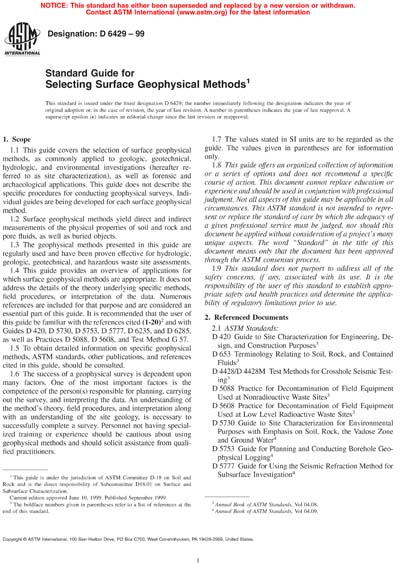Historical
ASTM D6429-99
Standard Guide for Selecting Surface Geophysical Methods
1.1 This guide covers the selection of surface geophysical methods, as commonly applied to geologic, geotechnical, hydrologic, and environmental investigations (hereafter referred to as site characterization), as well as forensic and archaeological applications. This guide does not describe the specific procedures for conducting geophysical surveys. Individual guides are being developed for each surface geophysical method.
1.2 Surface geophysical methods yield direct and indirect measurements of the physical properties of soil and rock and pore fluids, as well as buried objects.
1.3 The geophysical methods presented in this guide are regularly used and have been proven effective for hydrologic, geologic, geotechnical, and hazardous waste site assessments.
1.4 This guide provides an overview of applications for which surface geophysical methods are appropriate. It does not address the details of the theory underlying specific methods, field procedures, or interpretation of the data. Numerous references are included for that purpose and are considered an essential part of this guide. It is recommended that the user of this guide be familiar with references cited (1-20) and with Guides D 420, D 5730, D 5753, D 5777, D 6235, and D 6285, as well as Practices D 5088, D 5608, and Test Method G 57.
1.5 To obtain detailed information on specific geophysical methods, ASTM standards, other publications, and references cited in this guide, should be consulted.
1.6 This guide offers an organized collection of information or a series of options and does not recommend a specific course of action. This document cannot replace education or experience and should be used in conjunction with professional judgment. Not all aspects of this guide may be applicable in all circumstances. This ASTM standard is not intended to represent or replace the standard of care by which the adequacy of a given professional service must be judged, nor should this document be applied without consideration of a project's many unique aspects. The word "Standard" in the title of this document means only that the document has been approved through the ASTM consensus process.
1.7 The success of a geophysical survey is dependent upon many factors. One of the most important factors is the competence of the person(s) responsible for planning, carrying out the survey, and interpreting the data. An understanding of the method's theory, field procedures, and interpretation along with an understanding of the site geology, is necessary to successfully complete a survey. Personnel not having specialized training or experience should be cautious about using geophysical methods and should solicit assistance from qualified practioners.
1.8 The values stated in SI units are to be regarded as the guide. The values given in parentheses are for information only.
1.9 Precautions:
1.9.1 This guide does not purport to address all of the safety concerns, if any, associated with the use of the methods. If the methods are used at site with hazardous materials, operations, or equipment, it is the responsibility of the user of this guide to establish appropriate safety and health practices and to determine the applicability of any regulations prior to use.
1.10 This standard does not purport to address all of the safety concerns, if any, associated with its use. It is the responsibility of the user of this standard to establish appropriate safety and health practices and determine the applicability of regulatory limitations prior to use.
Content Provider
ASTM International [astm]






